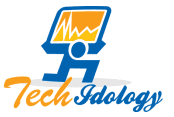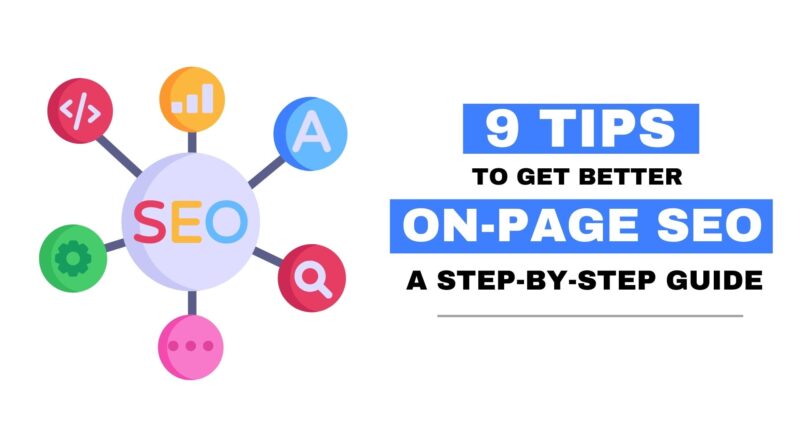9 Tips to Get Better On-Page SEO – A Step-By-Step Guide
On-page SEO is one of the most important steps to increase your website’s search traffic and drive conversions. In the last few years, Google has announced various algorithms.
Accordingly, these Google updates have forced SEO specialists to change their on-page SEO strategies in order to appear in the search engine results.
To stand out from the competitors in this digital era, you need to focus on on-page and off-page SEO tactics.
Keep reading this article if you want to make effective SEO strategies to improve your search ranks and increase traffic.
Table of Contents
What Does The Term On-Page SEO Mean?
On-page SEO is the process of optimizing web pages in order to increase a website’s search engine ranks and generate organic traffic.
In simple words, it means updating and optimizing your headlines, HTML elements (meta title, description, and header), and images, in addition to posting relevant and top-notch content.
It’s a much more complicated subject that has changed significantly over time. As a result, being up to date on the latest SEO best practices is necessary for you if you want to rank your pages.
How Important Is On-Page SEO For Your Site?
On-page SEO is crucial because it helps search engines comprehend your website and its content. Furthermore, it also helps them recognize how relevant your content is.
Following are the two factors that are becoming increasingly important in search engine rankings:
- Semantics
- Relevancy
Remember, Google minutely:
- Understands what users are looking for when they ask a particular search query
- Provides search results that are relevant to the user’s search query
If you want people to reach your page, you should develop a solid content strategy and focus on on-page SEO techniques.
On-page SEO helps you to drive more traffic to your site.
10 Actionable On-Page SEO Tips and Tricks That Help You Reach Goals
Focusing on these tips will help you optimize your content, authority, and rankings.
- Craft Unique Title Tags
The title tag serves as an initial cue for the subject matter of its page. It is displayed in both the search engine results pages and the browser window.
Many content writers ignore the significance of the title tag. If you are also one of those writers, you are incorrect. You should reconsider this step.
The title tag strongly impacts your site’s presence in the search results. A well-crafted title tag:
- Engages readers
- Improves visibility
- Helps you to rank the page
Accordingly, you should produce a top-notch title tag that would pique your readers’ interests.
- Write Brief Meta Descriptions
A meta description encourages readers to click through to your website and is displayed under the meta title and states what the article is about.
Including the main keyword naturally in the description helps you to compel people to read your article. Most importantly, you have to write it within 150-159 characters.
This is the reason many accomplished copywriters and content writers use an online character counter to trim the description’s length while ensuring that it directly resonates with readers. It helps you to count the number of characters and words you write. So, using a character counter enables you to stay within the required character limit.
In a nutshell, it assists you in crafting top-quality description that compels people to click through to your website.
- Write Compelling Headlines
Writing catchy headlines is a vital part of on-page SEO. This is because it is the first thing that grabs your site visitors’ attention.
These are your headlines that figure out whether or not your intended readers will read your post.
If you want your article to perform well, writing engaging headlines is an easy method to do it. Well-crafted headlines can boost the conversion rate of a post.
Including particular figures and facts in your headline is an efficient method to get visitors to read your post.
Every headline should be attention-getting. Plus, it would be best to use rationales like ways, tips, tricks, hacks, ingredients, ideas, etc.
- Craft SEO-Optimized Content
Keep your potential readers in mind while writing content. This will assist you in writing SEO-optimized content.
Not all blog entries are SEO-friendly, and putting your heart and soul into your writing would not guarantee traffic or ranks.
Producing content just for its sake does not help you drive conversions and increase your sales. Your content should be people-centric; therefore, craft high-quality.
Writing SEO-optimized content is significant because it attracts more potential clients to our website.
- Insert Keywords In The Best-Fit Place
Remember, almost 95% of people do not visit the second page of search results. So, if you do not use the exact keywords, your article will be at risk.
Therefore, using the right keywords in your content is crucial to get the organic traffic and sales you need.
Use a credible keyword searcher tool to highlight the primary and secondary keywords.
Add keywords in the titles, descriptions, headings, subheadings, and throughout the content in the best possible way. Plus, insert keywords in the URLs and images.
- Keep Your Users Engaged
Most significantly, make sure that users do not bounce back rather than they should remain on your page.
Undoubtedly, keeping your readers engaged is not an easy task. But it’s not impossible.
Your site content should bind readers and keep them engaged from top to bottom. This will show Google that readers love and appreciate your content.
In order to increase user engagement, follow these steps:
- Make your page’s speed faster
- Include bullets to make your content easy to read
- Incorporate images, videos, and infographics in your content
- Must include a strong call to action that encourages them to make a purchase
- Use attractive and clear headings that improve content readability
Also Read: Best SEO Trends To Start following
- Optimize Images
Images play a great role in SEO.
When people are searching some keywords, they look for images. Hence, images give you an edge over competitors.
Including relevant images in the content helps you engage readers until the end. So, make sure that you have included the optimized photos.
Image size impacts page speed; accordingly, you should compress the size of the images.
- Be Meticulous
Having highly relevant content on your page is good, but you have not done enough.
In order to win the position on the first page, you have to post comprehensive content that covers all the aspects of searchers.
How can I determine that my written content is of supreme level?
You have to do a detailed analysis of the top five pages of Google. Then, write content that covers all the key points. Plus, highlight the areas where your competitors are lacking.
It will give you an edge over competitors when you talk about those areas.
- Relevancy Is The Key
Relevance is another key component in the on-page SEO field. Therefore, you have to align your entire article according to the search intent.
If you succeed in delivering readers what they want, your chances of ranking will increase. Avoid exaggerating ideas. Instead, follow a natural approach to target the main points in your content.
In simple words, stay relevant to the content and cover everything in a chronological pattern.
Finally, publish your content and let it do the job.
Conclusion
In a nutshell, you should consider the on-page SEO technique for improving your search ranking. In addition, it helps you boost your rankings and drive more visitors and conversions.
On-page SEO is not limited to only optimizing the title tag and description. Instead, it is much more than that. Make sure that your article’s content tailors to your readers’ intent.
So roll up your sleeves and focus on on-page SEO.
You should consistently read your niche-related blogs and watch YouTube videos to stay up-to-date. It would be best to follow Bing and Google’s blogs.
FAQs
- What do you mean by on-page SEO?
On-site or copes with the practice of ranking your content in the SERPs and winning more organic traffic.
It involves posting unique, highly-relevant content containing optimized titles, headings, and content.
- What is the significance of on-page SEO?
On-site SEO is crucial because it assists you in analyzing your site and content. Furthermore, it also helps you to determine whether your written content is relevant.
- What are the crucial elements of on-page SEO?
On-page SEO covers all the factors you control on the website page—for example, content, titles, description, heading, images, and more.
Additionally, formatting also plays a significant role in SEO.
- What is an on-page SEO checklist?
- Addthemain keyword in the URL
- Use concise URLs
- Include primary keyword in meta title and description
- Use keywords in headings and subheadings
- Spread LSI on the entire piece of copy
- What are the benefits?
Following are the five killer benefits of on-page SEO:
- It helps you to get local visibility and reach the target audience
- It assists you in ranking in the search results.
- It enables you to obtain a higher crawl rate and CTR.
- It helps you to make your site unique.
- On-page SEO drives more conversions and generates more sales.
- Is there any way to stay updated with SEO?
Yes, there is!
You should consistently read your niche-related blogs and watch YouTube videos to stay up-to-date. It would be best to follow Bing and Google’s blogs.




